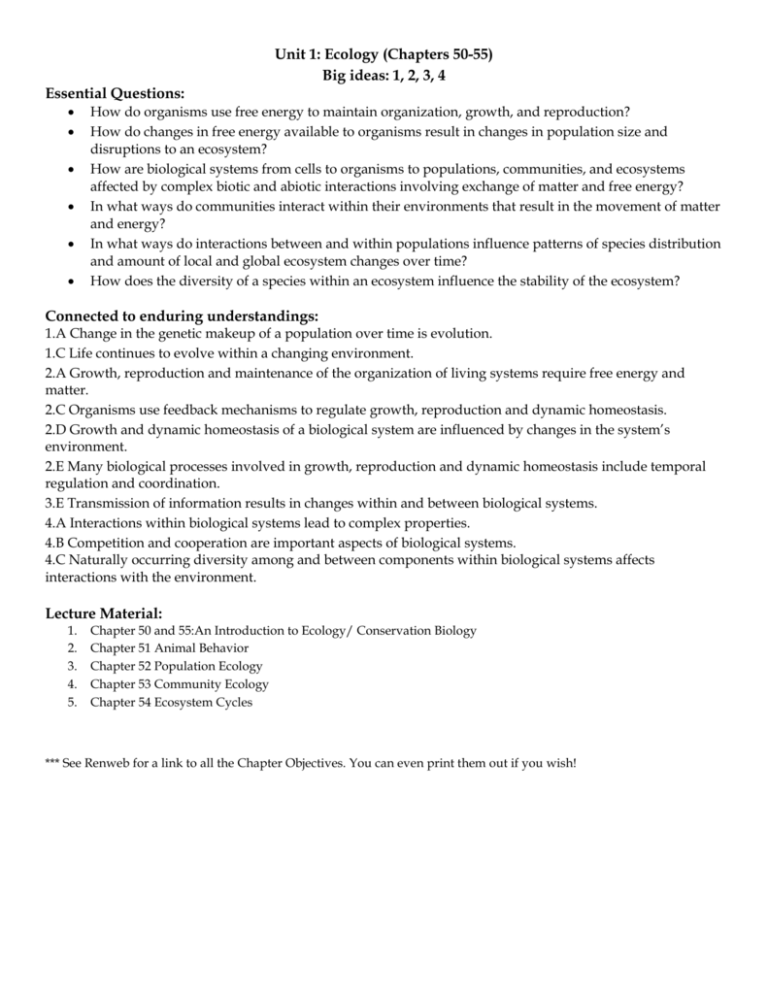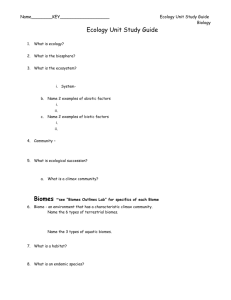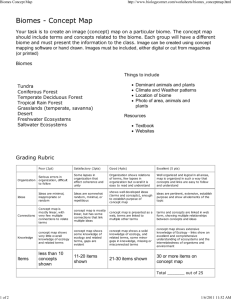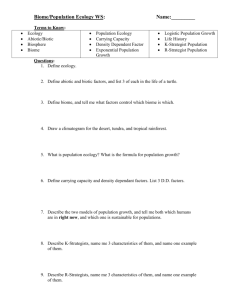Unit 1 Packet
advertisement

Unit 1: Ecology (Chapters 50-55) Big ideas: 1, 2, 3, 4 Essential Questions: How do organisms use free energy to maintain organization, growth, and reproduction? How do changes in free energy available to organisms result in changes in population size and disruptions to an ecosystem? How are biological systems from cells to organisms to populations, communities, and ecosystems affected by complex biotic and abiotic interactions involving exchange of matter and free energy? In what ways do communities interact within their environments that result in the movement of matter and energy? In what ways do interactions between and within populations influence patterns of species distribution and amount of local and global ecosystem changes over time? How does the diversity of a species within an ecosystem influence the stability of the ecosystem? Connected to enduring understandings: 1.A Change in the genetic makeup of a population over time is evolution. 1.C Life continues to evolve within a changing environment. 2.A Growth, reproduction and maintenance of the organization of living systems require free energy and matter. 2.C Organisms use feedback mechanisms to regulate growth, reproduction and dynamic homeostasis. 2.D Growth and dynamic homeostasis of a biological system are influenced by changes in the system’s environment. 2.E Many biological processes involved in growth, reproduction and dynamic homeostasis include temporal regulation and coordination. 3.E Transmission of information results in changes within and between biological systems. 4.A Interactions within biological systems lead to complex properties. 4.B Competition and cooperation are important aspects of biological systems. 4.C Naturally occurring diversity among and between components within biological systems affects interactions with the environment. Lecture Material: 1. 2. 3. 4. 5. Chapter 50 and 55:An Introduction to Ecology/ Conservation Biology Chapter 51 Animal Behavior Chapter 52 Population Ecology Chapter 53 Community Ecology Chapter 54 Ecosystem Cycles *** See Renweb for a link to all the Chapter Objectives. You can even print them out if you wish! Assignments: 1. Class Warm Ups Sheets (Dated!!!!) (If absent, include a blank page that says ABSENT) 2. All Lecture Notes (Labeled & Ordered) 3. Worksheets a. Biomes b. Behavioral Ecology c. Communities d. Ecosystems e. Biogeochemical Chemical Cycles 4. Chapter 50-55 Guided Reading 5. Practice FRQ activity (in class) 6. Take Home FRQ (revisions allowed) 7. Ecology Lab 11: Animal Behavior 8. Ecology Lab 12: Dissolved Oxygen Virtual Lab 9. Random Sampling Lab Activity 10. Biome Concept Map Poster (http://www.biologycorner.com/worksheets/biomes_conceptmap.html ) Assignments will be graded for content when turned in on the final Portfolio Due Date. Until then, they will show up as an X for completed or a 0 for incomplete. This should help you (and your parents) keep track of your progress on Renweb. Calendar: Date 8/18 8/20 8/22 8/26 8/28 9/2 9/4 9/8 9/10 Activities Lecture: An Introduction to Ecology& Conservation Biology Student Work Time Lecture: Animal Biology Student Work Time FRQ: Learning how to write AP Biology Essays Assign take home FRQ (Due when portfolios are due) Animal behavior Pre-Lab Animal Behavior Lab Lecture: Population Ecology Student Work Time Lecture: Community Ecology Random Sampling Activity Lecture: Ecosystem Cycles Student Work Time Review for Exam Study Guide Available Assemble Portfolios—ALL PORTFOLIOS DUE AT THE END OF THE CLASS PERIOD AP Biology Unit 1 Exam!!! Portfolio Grading Rubric: __ / 5 Binder __/ 5 Binder Cover Page __/ 5 Binder Big 4 Ideas on Back __/ 5 Binder Spine Labeled __/ 5 Syllabus __/ 5 LHS AP Bio Guide to Success __/ 5 Unit 1 Label or Divider __/ 5 Unit 1 Cover Sheet __/ 5 Unit 1 Table of Contents __/ 5 Unit 1 Warm Ups __/ 10 Lecture Notes __/ 40 Guided Reading Chapter 50-55 __/ 20 Worksheets __/ 20 Essay __/ 20 Random Sampling Activity __/ 40 Biome Poster Final Grade: ___________/ 200 Biomes - Concept Map Your task is to create an image (concept) map on a particular biome. The concept map should include terms and concepts related to the biome. Each group will have a different biome and must present the information to the class. Image can be created using concept mapping software or hand drawn. Images must be included, either digital or cut from magazines (or printed). Biomes Tundra Coniferous Forest Temperate Deciduous Forest Tropical Rain Forest Grasslands (temperate, savanna) Desert Freshwater Ecosystems Saltwater Ecosystems Instructions 1. Place your biome (choose 1 from the above list) as a center concept on your map. Your map will be created on a sheet of legal sized paper provided by the teacher. 2. Make four branches from the center point for each of the following categories: animals, plants, climate, and interesting facts. 3. Research your biome to include terms and ideas for each of those main categories and link them on your map. Include photos or other images where appropriate. Grading Rubric Poor (1pt) Satisfactory (2pts) Good (3pts) Excellent (4 pts) Organization Serious errors in organization, difficult to follow Some lapses in organization that effect coherence and unity Organization shows relations of terms, few lapses in organization but overall it is easy to read and understand Well organized and logical in all areas, map is organized in such a way that concepts and links are easy to follow and understand Ideas Ideas are minimal, inappropriate or random Ideas are somewhat random, minimal, or repetitious shows well developed ideas (terms and concepts), enough to establish purpose of concept map ideas are pertinent, extensive, establish purpose and show all elements of the topic Connections Concept map is mostly linear, with very few multiple connections to relate terms concept map is mostly linear, but has some connections that link multiple ideas concept map is presented as a web, terms are linked to multiple other terms terms and concepts are linked in web form, showing multiple relationships between concepts and ideas Knowledge concept map shows very little overall knowledge of ecology and related terms concept map shows some knowledge of ecology and related terms, gaps are evident concept map shows a solid knowledge of ecology, and related terms, some minor gaps in knowledge, missing or misconnected terms concept map shows extensive knowledge of Ecology links show an excellent and comprehensive understanding of ecosystems and the interrelatedness of organisms and environment Items less than 10 concepts shown 10-14 items shown 15-19 items shown 20 or more items on concept map Total _______ out of 20







